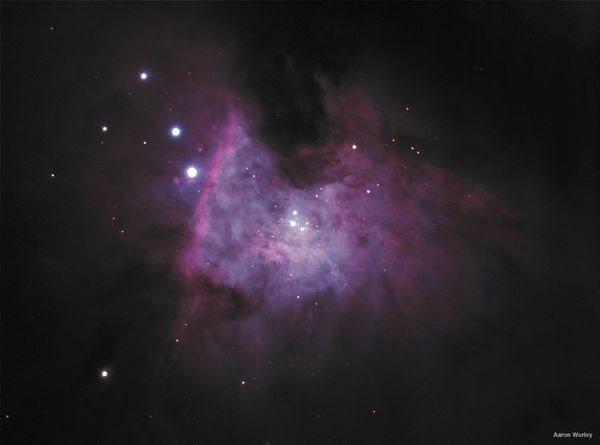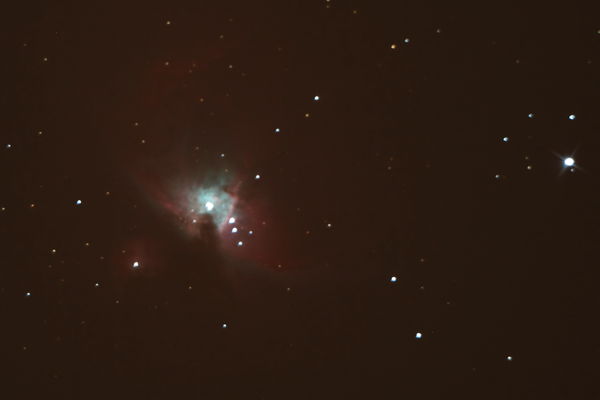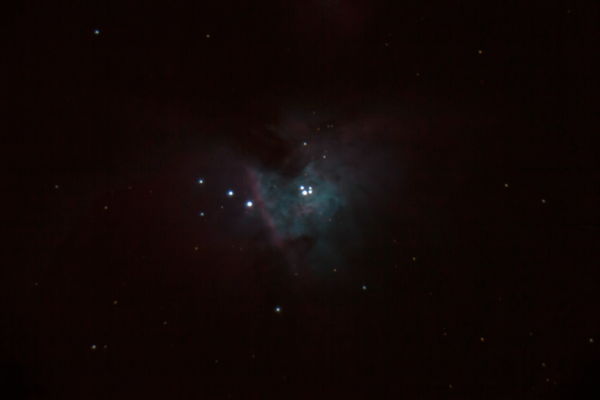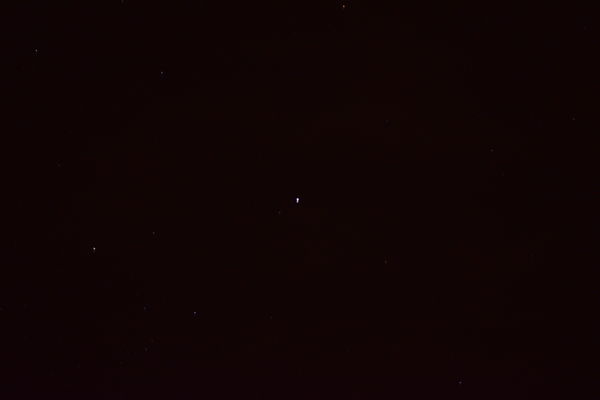Orion Nebula
Mar 15, 2015 00:46:35 #
Mar 15, 2015 01:34:16 #
SonnyE wrote:
I'd love to see what you can see with that long tube... :-D
Tomorrow night. Tonight I played with the 6" reflector.
Mar 15, 2015 01:37:57 #
northcoast42
Loc: Puget Sound, Washington
Albuqshutterbug wrote:
Little better alignment tonight.
Celestron Advanced VX Go To mount.
Celestron C8 SCT
f/10 fixed
2030mm fixed
ISO 800
15 second single exposure
Prime focus no extensions or tubes.
Celestron Advanced VX Go To mount.
Celestron C8 SCT
f/10 fixed
2030mm fixed
ISO 800
15 second single exposure
Prime focus no extensions or tubes.
Awesome shot Albuqshutterbug especially as a single exposure! Really nice! What camera were you using?
Mar 15, 2015 01:52:26 #
northcoast42 wrote:
Awesome shot Albuqshutterbug especially as a single exposure! Really nice! What camera were you using?
Thank you and sorry, the Canon 7D.
For comparison. Here is the 6" reflector f/5 at 60 seconds ISO 100 and the 7D.
Tracking is pretty close but my focus is off and I think my columniation is a bit off as well.
Mar 15, 2015 10:12:00 #
Albuqshutterbug wrote:
Thank you and sorry, the Canon 7D.
For comparison. Here is the 6" reflector f/5 at 60 seconds ISO 100 and the 7D.
Tracking is pretty close but my focus is off and I think my columniation is a bit off as well.
For comparison. Here is the 6" reflector f/5 at 60 seconds ISO 100 and the 7D.
Tracking is pretty close but my focus is off and I think my columniation is a bit off as well.
You are really getting the hang of it Jim, nice shot....
Craig
Mar 16, 2015 08:53:14 #
Albuqshutterbug wrote:
Little better alignment tonight.
Celestron Advanced VX Go To mount.
Celestron C8 SCT
f/10 fixed
2030mm fixed
ISO 800
15 second single exposure
Prime focus no extensions or tubes.
Celestron Advanced VX Go To mount.
Celestron C8 SCT
f/10 fixed
2030mm fixed
ISO 800
15 second single exposure
Prime focus no extensions or tubes.
If you look in the very center of the nebula, there is a tight grouping of 4 stars. It is called the Trapezium Cluster. Refer to:
http://www.lvastronomy.com/observing-challenge/144-february-theta-1-orionis-the-trapezium
This tiny cluster is used as a test to show the differences in sizes of telescopes. There are more than 4 stars in this cluster, but it takes larger telescopes to resolve. A small telescope can usually see 4. I went out last night with a small 4" scope and could resolve the 4.
Mar 16, 2015 12:33:58 #
JimH123 wrote:
If you look in the very center of the nebula, ther... (show quote)
It is fairly easy to see 4 stars in the Trapezium Cluster. It is much harder to see the 5th and 6th stars. I wonder if anyone is up to the task of producing a photograph that shows those next two stars. And by the way, there actually more than 6. But only a really big scope can show those stars.
Mar 16, 2015 20:27:32 #
SonnyE wrote:
I'd love to see what you can see with that long tube... :-D
Oh the chromatic junk was horrible with it last night.
I did not get anything salvageable.
Mar 16, 2015 20:30:30 #
JimH123 wrote:
It is fairly easy to see 4 stars in the Trapezium Cluster. It is much harder to see the 5th and 6th stars. I wonder if anyone is up to the task of producing a photograph that shows those next two stars. And by the way, there actually more than 6. But only a really big scope can show those stars.
If you look at my original shot in this post, are you talking about the 2 small stars at the top of trapezium and the 1 small star at the bottom? Download and zoom to see what I am talking about.
Mar 16, 2015 21:37:05 #
Albuqshutterbug wrote:
If you look at my original shot in this post, are you talking about the 2 small stars at the top of trapezium and the 1 small star at the bottom? Download and zoom to see what I am talking about.
I'm talking about the 4 stars in the middle of the blue portion of the Trapezium. They are overexposed and blooming quite large. With a better focus and a bit shorter exposure, they should look perfect.
I have attached a picture I found with Google. In the very center are 4 stars that are tightly grouped. There are actually more than 4 since this is a really good picture, but pick out the 4 brightest. This can be used a telescope test. To a small telescope, they will appear as one blob. To a larger scope, they are 4 distinct stars. And then with bigger and even bigger scopes, more than 4 stars begin to appear. Hubble can pick out hundreds! I believe your scope is large enough to see more than 4, but the focus needs to be right on the mark and the exposure controlled so they don't bloom. The next two stars, numbers 5 & 6 are considerably dimmer. And the next batch beyond that is even more dimmer.
What makes this one hard is that you are looking for dim stars in front of a bright background. This is what makes it such a good test of the scope.
I should also give credit to Aaron Worley whose picture was found by my Google search. I see he used this equipment:
Equipment: 9.25″ SCT, 0.5x reducer, DMK 41AF02.AS, LRGB filters, and he used a CCD, not a DSLR.
http://www.astronomycameras.com/blog/archive/20090406/trapezium-in-m42-by-aaron-worley/
Good luck.
Trapezium

Mar 17, 2015 00:53:32 #
JimH123 wrote:
I'm talking about the 4 stars in the middle of the... (show quote)
Stacking multiple video images will indeed produce this type of result. My shots are singles as I do not have a video setup yet. I'll take what I am getting for now but hope to improve in the future.
For single shots I am quite satisfied short of wanting a tighter focus. I shot this tonight and tried to narrow in on getting the small orange stars to come forward. I got one of them.
;)
Mar 17, 2015 08:31:13 #
Albuqshutterbug wrote:
Stacking multiple video images will indeed produce this type of result. My shots are singles as I do not have a video setup yet. I'll take what I am getting for now but hope to improve in the future.
For single shots I am quite satisfied short of wanting a tighter focus. I shot this tonight and tried to narrow in on getting the small orange stars to come forward. I got one of them.
;)
For single shots I am quite satisfied short of wanting a tighter focus. I shot this tonight and tried to narrow in on getting the small orange stars to come forward. I got one of them.
;)
Yes, quite an improvement. The Trapezium is now clearly resolved. And I can see the dimmer stars starting to become visible. And yes, stacking would be the next step.
Mar 17, 2015 09:19:49 #
JimH123 wrote:
Yes, quite an improvement. The Trapezium is now clearly resolved. And I can see the dimmer stars starting to become visible. And yes, stacking would be the next step.
I have the template to make a focus mask that may help and a Crayford focuser is on my list as well.
Little steps little improvements.
I appreciate all of the comments and tips. That's why we post here.
Happy St. Patrick's Day.
Mar 17, 2015 11:12:28 #
Happy St. Paddy's to you, too. ;)
Just call me, Blobs. :lol:
Just call me, Blobs. :lol:
Mar 17, 2015 11:19:00 #
SonnyE wrote:
Happy St. Paddy's to you, too. ;)
Just call me, Blobs. :lol:
Just call me, Blobs. :lol:
How are you tripping your shutter?
If you're not using a remote either wireless or wired that's likely what caused your streaking.
Pretty sure Polaris is on the center. ;)
If you want to reply, then register here. Registration is free and your account is created instantly, so you can post right away.





